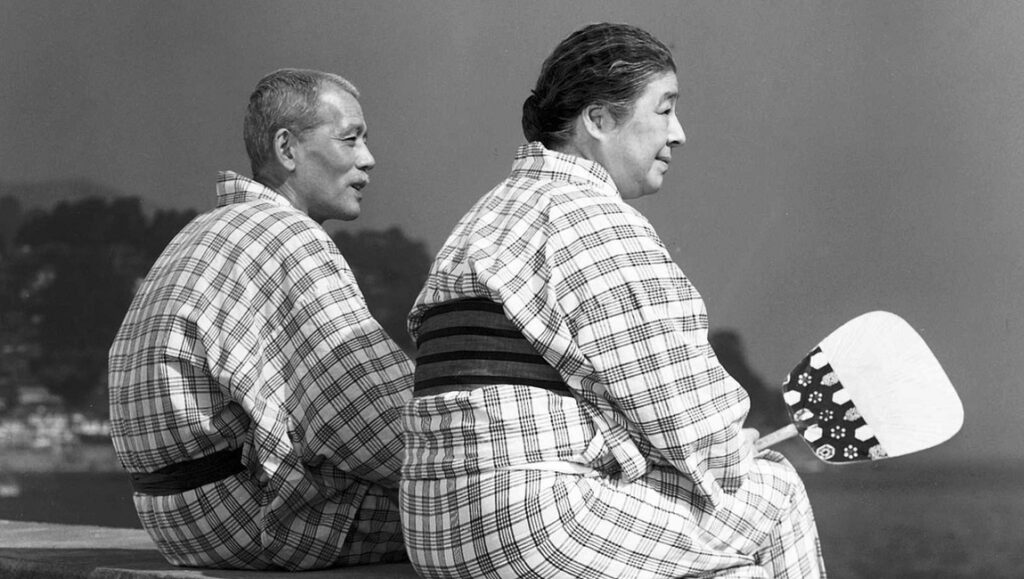Engagement with Yasujirō Ozu’s work often prompts descriptors like “restrained,” “artisanal,” or even “conservative,” and appraisals of his films regularly point to their stubborn minimalism as well as their distinct “Japan-ness.” As arguably the quintessential work of Ozu’s career, 1953’s Tokyo Story has become synonymous with its creator and his eccentricities, namely his lowkey style, slow-moving stories, and domestic setting, and given its pared-down form, the film stands as something of an outlier amidst the likes of Jeanne Dielman, 23 quai du Commerce, 1080 Bruxelles, Vertigo, or Citizen Kane, the films it trails in the most recent BFI Sight and Sound poll.[ppp_patron_only level=”3″ silent=”no”]
But despite prevailing conceptions, Ozu’s oeuvre is surprisingly heterogenous, and the image of the somber, ascetic cineaste isn’t borne out by the breadth his work, which is as rich emotionally as it is formally. Take, for instance, Dragnet Girl, a 1933 curio that toyed with the conventions of the American gangster film (his second attempt after 1930’s Walk Cheerfully); and elsewhere, both I Was Born, But… and Good Morning frequently aligned with the perspectives (and mischievous antics) of its child characters. (It’s worth noting that the number of farts in the latter rivals any lowbrow, post-Zucker brothers American comedy.) Which is to say, there is a playfulness which permeates much of the director’s work that is just as essential as its tender emotionality, the melancholy drama with which Ozu is most commonly associated emerging from a rather grounded portrayal of middle-class life.
Japanese film distributors considered Ozu “too Japanese” to be successfully exported to the West, and this impression has clung to his legacy and only added to the reputation he’s been saddled with in the eyes of budding Western cinephiles. This assessment, however, downplays the significance American cinema played in his development, Josef von Sternberg and Ernst Lubitsch being particular influences early on. In fact, Tokyo Story‘s premise is based on Leo McCarey’s 1937 drama Make Way for Tomorrow — which only co-screenwriter Kogo Noda had seen — and the film sets its generation-gap tale against the rapid changes Japanese society was undergoing. Due to its stature, even amongst his other celebrated works, it’s sometimes neglected that Tokyo Story is actually the concluding entry in Ozu’s “Noriko Trilogy,” a trio of films featuring the Noriko archetype, portrayed by Setsuko Hara. Like the preceding entries, Late Spring (1949) and Early Summer (1951) — Ozu loved those seasonal titles — Tokyo Story casts Noriko as a single (or in this instance, widowed) woman navigating post-war Japan. The different incarnations of Noriko all share a warmth and sense of duty in common, and in one way or the other, their virtue proves itself detrimental to their happiness.
When the retired couple at the heart of the Tokyo Story, Shūkichi (Chishū Ryū) and Tomi Hirayama (Chieko Higashiyama), make the trip from Onomichi to Tokyo to visit their adult children, their hopes for a pleasant family reunion are dashed when their kids are either unable or unwilling to make time for them. Noriko, their widowed daughter-in-law, however, is happy to look after them, even taking time off from work to go on a sightseeing trip through the city. Noriko’s husband, Shōji, went missing during the Pacific War and is presumed dead, and his parents have repeatedly encouraged her to move on and remarry. But, still bound by the love she has for her husband, she has been hesitant to do so. Soon tired of being moved from one household to the next, the parents decide to make their way back home. On the way, Tomi, who has been experiencing dizzy spells, suddenly falls ill, and her condition worsens further once they make it back to Onomichi. Noriko, along with two of Tomi’s children, make it to the seaside town in time to spend Tomi’s final moments with her, but after her funeral, the kids immediately abscond, leaving only Noriko to spend a little more time with Shūkichi. He once again encourages her to start a new life, and the two find fleeting comfort in their shared loneliness before she ultimately has to return to Tokyo as well.
Ozu’s first sound film, The Only Son (1936), opens with an epigraph that states, “Tragedy in life starts with the bondage of parent and child,” and this aphorism reveals so much about Ozu’s work going forward that he might as well have included it at the beginning of each subsequent effort. The passage of time, lodged potently in the subtext of most, if not all, of Ozu’s post-war works, is rendered cruel not just for the way it changes the world at large — Tokyo, here, represents an encroaching modernity that is foreign to the parents — but also for what it leaves behind. It’s really this theme of loneliness around which Tokyo Story revolves. But like the film that inspired it, Tokyo Story eschews any moralizing about the children’s selfishness. “They have their own affairs,” says Noriko of her seemingly indifferent siblings-in-law. “Children do drift away from their parents.” The film’s final shot of Shūkichi, by contrast, implies a more complicated side to that truism: the patriarch sitting alone in his living room, facing a life without his companion, his kids, and even his loyal daughter-in-law. It’s one of many heart-wrenching Ozu endings — the hands that suddenly stop peeling an apple in Late Spring, the shots of the empty rooms in An Autumn Afternoon (1962) — but there is a profound, lingering sadness here all its own, with Ozu depicting the way that time robs us all of the things we cherish most.[/ppp_patron_only]


Comments are closed.